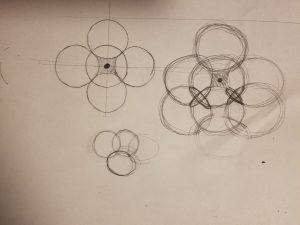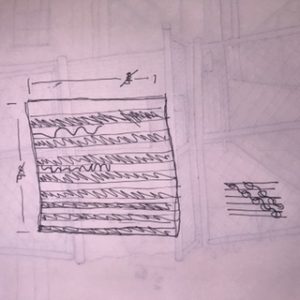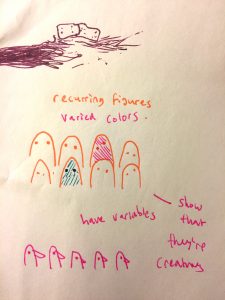sketch
function setup() {
createCanvas(480, 480);
background(220);
}
function draw() {
for (x = 0; x <= 480;x += 120) {
for (y = 0; y <= 480; y += 120) {
//branches thicc
stroke(105,72,31);
strokeWeight(2);
line(x+35,y+0,x+35,y+17);
line(x+35,y+17,x+58,y+16);
line(x+58,y+16,x+58,y+75);
line(x+58,y+75,x+35,y+75);
line(x+35,y+75,x+35,y+98);
line(x+35,y+98,x+25,y+98);
line(x+25,y+98,x+25,y+112);
line(x+25,y+112,x+35,y+112);
line(x+35,y+112,x+35,y+120);
line(x+97,y+0,x+97,y+10);
line(x+96,y+10,x+83,y+10);
line(x+83,y+10,x+83,y+28);
line(x+83,y+28,x+58,y+28);
line(x+58,y+59,x+84,y+59);
line(x+84,y+59,x+84,y+96);
line(x+84,y+96,x+97,y+96);
line(x+97,y+96,x+97,y+120);
//branches thin left
strokeWeight(1);
line(x+0,y+68,x+13,y+68);
line(x+13,y+68,x+13,y+78);
line(x+13,y+78,x+27,y+78);
line(x+27,y+78,x+27,y+67);
line(x+27,y+67,x+31,y+67);
line(x+31,y+67,x+31,y+54);
line(x+31,y+54,x+58,y+54);
//branches thin right
line(x+97,y+10,x+107,y+10);
line(x+107,y+10,x+107,y+60);
line(x+107,y+60,x+100,y+60);
line(x+100,y+60,x+100,y+67);
line(x+100,y+67,x+120,y+67);
//leaf top
stroke(26,175,75);
strokeWeight(2);
line(x+7,y+0,x+5,y+2);
line(x+5,y+2,x+21,y+1);
line(x+21,y+1,x+22,y+0);
//leaf 2nd to top
line(x+35,y+16,x+37,y+26);
line(x+37,y+26,x+26,y+37);
line(x+26,y+37,x+25,y+22);
line(x+25,y+22,x+35,y+16);
//leaf 3rd to top
line(x+83,y+28,x+83,y+35);
line(x+83,y+35,x+101,y+42);
line(x+101,y+42,x+95,y+28);
line(x+95,y+28,x+83,y+28);
//leaf 4th to top
line(x+84,y+86,x+95,y+77);
line(x+95,y+77,x+111,y+73);
line(x+111,y+73,x+101,y+87);
line(x+101,y+87,x+84,y+86);
//leaf bottom
line(x+7,y+120,x+19,y+109);
line(x+19,y+109,x+25,y+112);
line(x+25,y+112,x+22,y+120);
//rose
stroke(237,71,51);
line(x+54,y+90,x+40,y+102);
line(x+40,y+102,x+35,y+112);
line(x+35,y+112,x+45,y+115);
line(x+45,y+115,x+58,y+113);
line(x+58,y+113,x+57,y+97);
line(x+50,y+94,x+48,y+102);
line(x+48,y+102,x+51,y+108);
line(x+51,y+108,x+58,y+113);
line(x+35,y+112,x+48,y+102);
noStroke();
fill(237,71,51);
triangle(x+53,y+96,x+51,y+102,x+53,y+102);
triangle(x+51,y+102,x+55,y+101,x+54,y+107);
}
}
}


I started with an idea to have geometric natural figures. I started with various sketches, but decided to go with the one posted above. All the branches connect to each other to create a cohesive wallpaper. The sketch was remade in illustrator so I could find the exact pixels/locations of the lines. All in all, this was a fairly tedious project because I had to simply create lines for everything, thus having to check the pixels for everything.
![[OLD FALL 2017] 15-104 • Introduction to Computing for Creative Practice](../../../../wp-content/uploads/2020/08/stop-banner.png)







